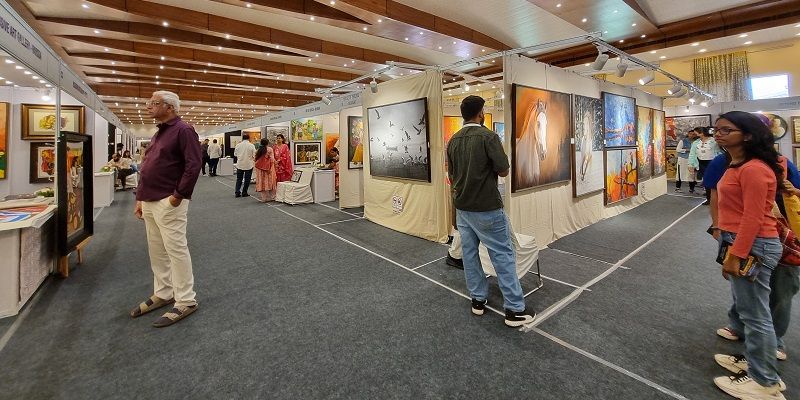Launched in 2014, PhotoSparks is a weekly feature from YourStory, with photographs that celebrate the spirit of creativity and innovation. In the earlier 880 posts, we featured an art festival, cartoon gallery. world music festival, telecom expo, millets fair, climate change expo, wildlife conference, startup festival, Diwali rangoli, and jazz festival.
The India Art Festival (IAF) recently wrapped up its Hyderabad edition, with a wide range of artistic themes, styles and genres. The next edition will be in New Delhi in November (see our coverage of IAF editions in Mumbai and Bengaluru here).
In this photo essay series, three exhibitors from the Hyderabad edition share insights on what art means to them and how they got started in their artistic journeys. They also describe their choice of style and genre.
The works of Mumbai-based artist Praveena Parepalli are rooted in themes of Indian rivers and wildlife. “Though I studied engineering in Hyderabad and completed my master’s degree in the US, my true discipline is observation,” she tells YourStory.
“Charcoal is my first language now; it helps me hold tension between the sacred and the forgotten. My practice flows with the rivers I draw—across regions, myths, and time,” she adds.
Her works address lost ecologies and unspoken stories. “Some of us are not trained to be artists—we are wired that way from the start,” she says.
Saurabh Dingare graduated from Abhinav Art College and MIT in Pune. He also has an Art Teacher’s Diploma from the Department of Fine Arts at Savitribai Phule Pune University.
“My current art style is an amalgamation of traditional culture and figurative compositions which I paint in my own style,” he describes.
Nabanita Ray and Rajendra Ray are an artist couple in Hyderabad who founded Art and Designer Studio. Both of them participated at the IAF exhibition.
“My hometown is Cuttack, Odisha. I completed my BFA from Government College of Art and Craft, Khallikote, under Utkal University, Bhubaneswar, Odisha, where I built my foundation in fine art,” Rajendra Ray says.
For Parepalli, art is not an escape from life—it is a confrontation with it. “There was a long pause when life asked me to be practical, and I obliged. But silence can grow heavy when you are not making,” she recalls.
“It took me years to realise that art is my emotional compass. It tells me when I have drifted too far from myself,” she describes.
Now in her forties, she feels art is like both a mirror and a map. “Art allows me to explore without answers, to speak without noise. The act of drawing, of layering, of making marks that do not ask permission—that is what keeps me facing forward,” Parepalli says.
“For me, art is nothing but my daily life,” Dingare says. This includes imaginary thoughts as well as portraits from past incidents of his life. He sees art as motivational as well as inspirational.
From the beginning, Ray’s main focus has been on realistic art. “But I also enjoy exploring experimental work. I believe every artwork should carry a story or a purpose,” he affirms.
During his student days, he created many oil paintings and portraits, which helped shape his foundation. “Nowadays, I find joy in playing with watercolours and acrylics,” Ray says.
He explores new techniques while staying true to the emotions and stories behind each piece. Creating a work of art needs the right mood and a suitable environment.
“Creation also requires a strong concept. I often find myself spending more time thinking, reflecting, and searching for the right story or idea rather than rushing into creating,” he explains.
The act of painting is core to practice and improvement. “But the process of discovering a meaningful concept is just as important as the act of painting itself,” he affirms.
“It is this depth and intention that makes each artwork truly personal and fulfilling,” Ray signs off.
Now what have you done today to pause in your busy schedule and harness your creative side for a better world?
(All photographs were taken by Madanmohan Rao on location at India Art Festival in Hyderabad.)
